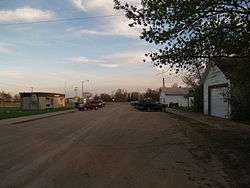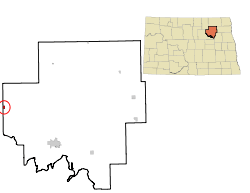Churchs Ferry, North Dakota
Churchs Ferry is a city in Ramsey County, North Dakota, United States that has been impacted by the expansion of nearby Devils Lake. The population was 12 at the 2010 census.[5] Churchs Ferry was founded in 1886.
Churchs Ferry, North Dakota | |
|---|---|
 Street in Churchs Ferry | |
 Location of Churchs Ferry, North Dakota | |
| Coordinates: 48°16′8″N 99°11′47″W | |
| Country | United States |
| State | North Dakota |
| County | Ramsey |
| Area | |
| • Total | 0.43 sq mi (1.12 km2) |
| • Land | 0.43 sq mi (1.12 km2) |
| • Water | 0.00 sq mi (0.00 km2) |
| Elevation | 1,450 ft (442 m) |
| Population | |
| • Total | 12 |
| • Estimate (2019)[3] | 12 |
| • Density | 27.78/sq mi (10.72/km2) |
| Time zone | UTC-6 (Central (CST)) |
| • Summer (DST) | UTC-5 (CDT) |
| ZIP code | 58325 |
| Area code(s) | 701 |
| FIPS code | 38-14140 |
| GNIS feature ID | 1028374[4] |
History
Devils Lake began rising in the early 1990s, and more than 400 homes around the lake have been relocated or destroyed. This includes Churchs Ferry, one of two municipalities that have been bought out by government agencies. The other is Penn, although some people remain in both communities.
Devils Lake keeps getting larger as its outlet (Tolna Coulee) is significantly higher than the rest of the lake. In the 1880s, the lake was large enough that a man by the name of Irvine Church once operated a ferry in the area (hence the town's name), but by 1940, the lake had all but dried out. The lake is now growing back towards its maximum size again.
On January 10, 2012, Churchs Ferry residents voted 5 to 2 to remain an incorporated town.[6]
Geography
Churchs Ferry is located at 48°16′8″N 99°11′47″W (48.268898, -99.196487).[7]
According to the United States Census Bureau, the city has a total area of 0.43 square miles (1.11 km2), all of it land.[8]
Demographics
| Historical population | |||
|---|---|---|---|
| Census | Pop. | %± | |
| 1900 | 264 | — | |
| 1910 | 457 | 73.1% | |
| 1920 | 353 | −22.8% | |
| 1930 | 295 | −16.4% | |
| 1940 | 244 | −17.3% | |
| 1950 | 223 | −8.6% | |
| 1960 | 161 | −27.8% | |
| 1970 | 139 | −13.7% | |
| 1980 | 139 | 0.0% | |
| 1990 | 118 | −15.1% | |
| 2000 | 77 | −34.7% | |
| 2010 | 12 | −84.4% | |
| Est. 2019 | 12 | [3] | 0.0% |
| U.S. Decennial Census[9] 2018 Estimate[10] | |||
2010 census
As of the census[2] of 2010, there were 12 people, 5 households, and 5 families residing in the city. The population density was 27.9 inhabitants per square mile (10.8/km2). There were 5 housing units at an average density of 11.6 per square mile (4.5/km2). The racial makeup of the city was 100.0% White.
There were 5 households, of which 20.0% had children under the age of 18 living with them and 100.0% were married couples living together. 0.0% of all households were made up of individuals. The average household size was 2.40 and the average family size was 2.40.
The median age in the city was 48.5 years. 8.3% of residents were under the age of 18; 8.3% were between the ages of 18 and 24; 25% were from 25 to 44; 58.4% were from 45 to 64; and 0.0% were 65 years of age or older. The gender makeup of the city was 50.0% male and 50.0% female.
2000 census
As of the census of 2000, there were 77 people, 33 households, and 26 families residing in the city. The population density was 178.2 people per square mile (69.1/km2). There were 46 housing units at an average density of 106.5 per square mile (41.3/km2). The racial makeup of the city was 100.00% White.
There were 33 households, out of which 21.2% had children under the age of 18 living with them, 63.6% were married couples living together, 9.1% had a female householder with no husband present, and 21.2% were non-families. 21.2% of all households were made up of individuals, and 12.1% had someone living alone who was 65 years of age or older. The average household size was 2.33 and the average family size was 2.50.
In the city, the population was spread out, with 19.5% under the age of 18, 3.9% from 18 to 24, 23.4% from 25 to 44, 36.4% from 45 to 64, and 16.9% who were 65 years of age or older. The median age was 48 years. For every 100 females, there were 102.6 males. For every 100 females age 18 and over, there were 106.7 males.
The median income for a household in the city was $33,438, and the median income for a family was $60,313. Males had a median income of $30,625 versus $33,750 for females. The per capita income for the city was $18,327. None of the population and none of the families were below the poverty line.
References
- "2019 U.S. Gazetteer Files". United States Census Bureau. Retrieved July 27, 2020.
- "U.S. Census website". United States Census Bureau. Retrieved June 14, 2012.
- "Population and Housing Unit Estimates". United States Census Bureau. May 24, 2020. Retrieved May 27, 2020.
- "US Board on Geographic Names". United States Geological Survey. October 25, 2007. Retrieved January 31, 2008.
- "2010 Census Redistricting Data (Public Law 94-171) Summary File". American FactFinder. United States Census Bureau. Retrieved May 2, 2011.
- "Tiny Churchs Ferry, ND, Saved at Election by 5-2 Vote", WDAZ-TV, "Archived copy". Archived from the original on 2013-02-17. Retrieved 2012-01-11.CS1 maint: archived copy as title (link) retrieved 1/10/2012
- "US Gazetteer files: 2010, 2000, and 1990". United States Census Bureau. 2011-02-12. Retrieved 2011-04-23.
- "US Gazetteer files 2010". United States Census Bureau. Archived from the original on 2012-01-25. Retrieved 2012-06-14.
- United States Census Bureau. "Census of Population and Housing". Retrieved February 15, 2014.
- "Population Estimates". United States Census Bureau. Retrieved June 4, 2019.
